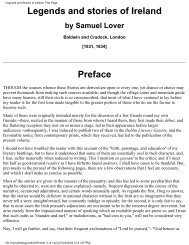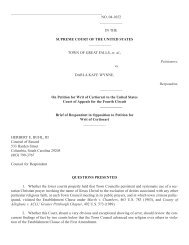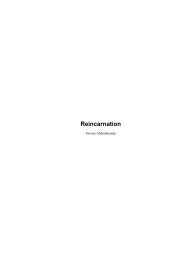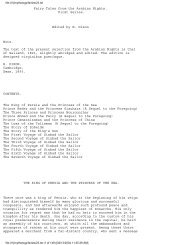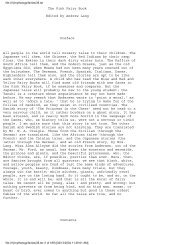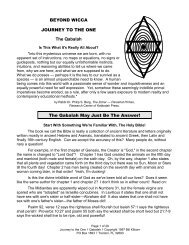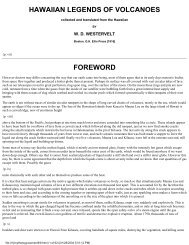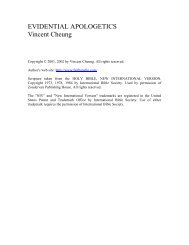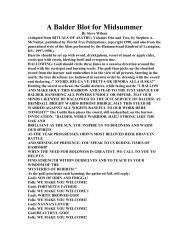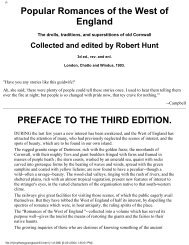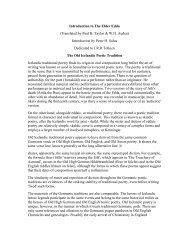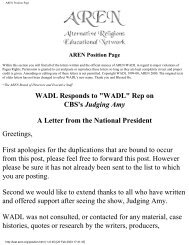Tales and Traditions of the Eskimo - Alternative Religions ...
Tales and Traditions of the Eskimo - Alternative Religions ...
Tales and Traditions of the Eskimo - Alternative Religions ...
You also want an ePaper? Increase the reach of your titles
YUMPU automatically turns print PDFs into web optimized ePapers that Google loves.
<strong>Tales</strong> <strong>and</strong> <strong>Traditions</strong> <strong>of</strong> <strong>the</strong> <strong>Eskimo</strong> - Title Page<br />
tuvik, shoulders; tatdlíka, my arms; agssait, fingers or h<strong>and</strong>; to8o, death; to8usso8, dead; nigdlerto8,<br />
cool; panerto8, dry; masagto8, wet; ûnarto8, hot; ingne8, fire. The apparent differences between <strong>the</strong>se<br />
two lists seem evidently to have arisen from mere misunderst<strong>and</strong>ing, without any real variation between<br />
<strong>the</strong> languages. On comparing, in <strong>the</strong> same manner, <strong>the</strong> rest <strong>of</strong> <strong>the</strong> lists <strong>of</strong> words from Behring Strait,<br />
two-thirds or three-fourths <strong>of</strong> <strong>the</strong> words are found to be more or less Greenl<strong>and</strong>ish. Moreover, taking into<br />
consideration <strong>the</strong> manner in which travellers have been enabled to communicate with one tribe <strong>of</strong><br />
<strong>Eskimo</strong>, by interpreters taken from ano<strong>the</strong>r, <strong>and</strong> that <strong>the</strong> difference between <strong>the</strong> Greenl<strong>and</strong> p. 14 <strong>and</strong> <strong>the</strong><br />
Labrador is smaller than, for instance, between Swedish <strong>and</strong> Danish, one is induced to assume an affinity<br />
<strong>of</strong> language among all <strong>the</strong> real <strong>Eskimo</strong> sufficient to allow mutual intercourse everywhere. On <strong>the</strong> o<strong>the</strong>r<br />
h<strong>and</strong>, it cannot be denied that <strong>the</strong> language <strong>of</strong> <strong>the</strong> <strong>Eskimo</strong> to <strong>the</strong> west <strong>of</strong> <strong>the</strong> Mackenzie is considerably<br />
different from that <strong>of</strong> <strong>the</strong> eastern tribes.<br />
Taking it for granted that Greenl<strong>and</strong>ish may be held to represent <strong>the</strong> <strong>Eskimo</strong> tongue in general, we shall<br />
endeavour to give an idea <strong>of</strong> its remarkable construction. Its most striking general peculiarity is <strong>the</strong><br />
length <strong>of</strong> its words; <strong>and</strong> this, in fact, expresses its chief dissimilarity from all languages, except <strong>the</strong><br />
American. What in o<strong>the</strong>r tongues may dem<strong>and</strong> a whole sentence, <strong>and</strong> even additional dependent<br />
sentences, in Greenl<strong>and</strong>ish may sometimes be expressed by a single verb. Consequently, Greenl<strong>and</strong>ish<br />
grammar has both to construct words <strong>and</strong> to fix <strong>the</strong>m in <strong>the</strong> sentence. This construction is effected by <strong>the</strong><br />
help <strong>of</strong> additional elements or imperfect words, having no meaning by <strong>the</strong>mselves, but expressive as<br />
additions to <strong>the</strong> main word, with which <strong>the</strong>y can be combined in varieties <strong>of</strong> number <strong>and</strong> order, every<br />
combination altering or modifying <strong>the</strong> sense <strong>of</strong> <strong>the</strong> radical or adding a certain complexity <strong>of</strong> notions to it.<br />
Composition is completed by flexion, <strong>and</strong> particularly by conjugation, which not only, as in several o<strong>the</strong>r<br />
dialects, can make <strong>the</strong> verb include a pronoun as subject, but also as object, <strong>and</strong> in this way can form a<br />
sentence by itself, whereby <strong>the</strong>se additional elements may render <strong>the</strong> sentence compound, or even<br />
include o<strong>the</strong>r sentences. The following abstract <strong>of</strong> Samuel Kleinschmidt's Greenl<strong>and</strong>ish grammar will<br />
give a sufficient idea <strong>of</strong> this process:<br />
Writing <strong>and</strong> pronunciation.The language is written with <strong>the</strong> same letters as <strong>the</strong> German, only omitting<br />
some, <strong>and</strong> with <strong>the</strong> addition <strong>of</strong> <strong>the</strong> following:<br />
8, differing from k by its being formed in <strong>the</strong> remotest p. 15 part <strong>of</strong> <strong>the</strong> mouth, <strong>and</strong> sounding as something<br />
between gh, rk, <strong>and</strong> rkr.<br />
r , sounding like a very guttural German ch. [The letter r is sometimes, but not necessarily, marked with<br />
an apostrophe, or headed by a comma, to make it sound like a very guttural German ch. {from <strong>the</strong><br />
errata}]<br />
ss, like <strong>the</strong> French j.<br />
ng <strong>and</strong> rng, nasal sounds.<br />
The pronunciation <strong>of</strong> <strong>the</strong> vowels is <strong>of</strong>ten modified by <strong>the</strong> next consonants. The letter a is <strong>of</strong>ten heard as<br />
in <strong>the</strong> English word at. The accents ´ ^ ~, which show whe<strong>the</strong>r <strong>the</strong> syllable is to be pronounced sharp,<br />
long, or long combined with sharp, are <strong>of</strong> <strong>the</strong> greatest importance as to <strong>the</strong> sense <strong>of</strong> a word. O<strong>the</strong>rwise,<br />
<strong>the</strong> letters have mostly <strong>the</strong> same power as in German <strong>and</strong> <strong>the</strong> Sc<strong>and</strong>inavian tongues.<br />
Greenl<strong>and</strong>ish likes simplicity in its syllables, preferring those composed <strong>of</strong> one vowel <strong>and</strong> one consonant.<br />
More than one consonant in a syllable is not allowed, if any harshness should arise. No word can end<br />
with o<strong>the</strong>r consonants than 8, k, p, <strong>and</strong> t, nor begin with o<strong>the</strong>rs than <strong>the</strong>se, <strong>and</strong> m, n, <strong>and</strong> s. All <strong>the</strong><br />
file:///I|/mythology/american indian/24/24.html (16 <strong>of</strong> 317) [01/24/2004 8:57:48 AM]



